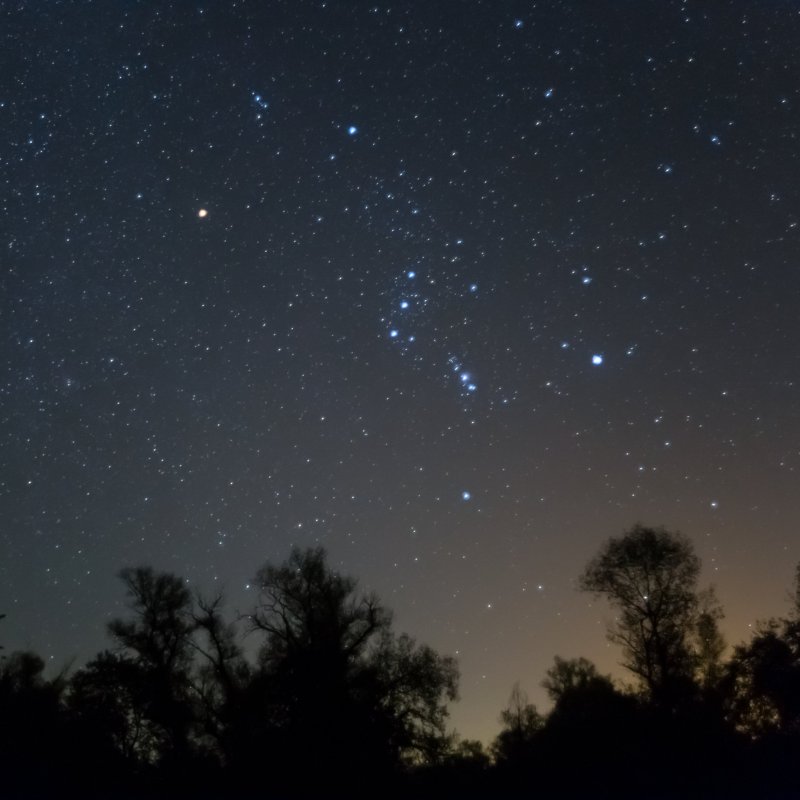
The stars seem to shine more brightly on a crisp, clear winter night than at any other time of the year. But the difference in clarity is not the reason for this; in fact, according to scientific measurements, there is no difference in the clarity of the night skies in the winter and any other cloudless night of the year. The actual difference is that in the northern hemisphere, more bright stars are visible in the winter sky, which also accounts for more star groups or constellations.
Videos by TravelAwaits
Identifying the constellations is one of the most fun elements of exploring the night skies from our backyards. The canopy of stars is like a celestial map, with constellations offering points of interest where we can stop to explore. Named after mythological creatures, they also connect us to ancient people who lived on earth before us and saw the same stars and same constellations, and eventually named them.
Though they saw the same skies, people from different cultures saw different images depicted in the stars. The images they saw reflected their stories and their beliefs. We usually talk about the constellations as they are seen in the northern hemisphere and use the names given to them by the Western civilizations, based on Greek and Roman mythology. With these considerations in mind, the following, identified by their Greek- and Roman-derived names, are the most prominent constellations we can see in our winter skies.
1. Orion
The winter sky’s most impressive constellation, Orion, named after the hunter of Greek mythology, is situated right in the middle of the night sky. Unlike most constellations, where it’s hard to find the correlation to their namesake, Orion actually looks like the outline of a human figure. Look for its most recognizable feature first: his hunter’s belt, formed by three bright stars close to each other, forming an unmistakable line. Surrounding the belt, four stars form Orion’s shoulders and legs, and from there, you can follow the outline of the whole figure.
Orion is a winter favorite not only because it’s the easiest to find and recognize, but for two of its brightest, non-belt stars. Betelgeuse is one of the largest stars known to us, a red supergiant, and Rigel is a cooler blue supergiant.
Besides all this, Orion is home to a stellar nursery, a diffuse cloud of dust and gas, the famous Orion nebula, which is visible with the naked eye. Seen as the middle star in his sword, it appears as a fuzzy star with the naked eye, but with binoculars or a small telescope, you’ll see it as a nebula, a cluster of stars.
You can find Orion on any clear winter evening soon after sunset — you don’t have to stay up all night to find it. Look south, almost halfway between the horizon and the point directly overhead, to see it.
2. Taurus
Taurus represents Zeus himself, in his form as a white bull. According to Greek mythology, he transformed himself into the beautiful white bull to abduct the Phoenician princess Europa.
The most spectacular constellation of the winter sky, Taurus features two of its brightest star clusters. Representing the bull’s head, the V-shaped Hyades cluster features the constellation’s brightest star, Aldebaran, as its fiery red eye. The Pleiades star cluster, also known as the Seven Sisters, represents the bull’s shoulder. Taurus is also home to the star Elnath, the closest bright star directly opposite from our Milky Way’s center. Elnath, which has a blue-white color, represents the bull’s northern horn, and it’s the second brightest star in the constellation.
Besides all this, Taurus is the radiant point for the annual Taurid Meteor shower in November and features the famous Crab Nebula (only visible through a telescope), the bright remains of a supernova explosion seen from earth in 1054.
Using Orion’s belt as a reference, you can easily find Taurus the bull; if you extend an imaginary line from the hunter’s belt to the right, it points to Aldebaran, the bull’s red eye.
3. Canis Major
The same imaginary line extended from Orion’s belt in the opposite direction (to the left) points to the brightest star in the Canis Major constellation. Representing Orion’s larger hunting dog, Canis Major is close to the horizon in the winter skies of the Northern Hemisphere.
Sirius, also known as the Dog Star, is the brightest star not only in its constellation but in our whole winter sky, since at only 8.6 light-years from Earth, it is closest to us. Besides Sirius, Canis Major is home to a dwarf galaxy, an open cluster, and two colliding spiral galaxies, all visible through telescopes.
4. Gemini
Gemini, Latin for twins, is the constellation associated with the twin brothers Castor and Pollux, sons of Zeus or Jupiter in Greek and Roman mythology, gods of sailing and horsemanship.
Their constellation is harder to recognize. It takes a bit of imagination to see the two stick-figures near each other. It’s easiest to find by looking for its two brightest stars, Castor and Pollux, which correspond to the heads of the twins. Castor is really a star system rather than one star, which appears as a cooler, blue-white color, while Pollux is an orange giant star. Castor appears higher and to the right, while Pollux is on the left, and appears slightly lower.
Look for them near Orion’s left shoulder. At this time of the year, they appear to be lying down with their feet near Orion’s arm.
5. Auriga
Auriga, Latin for charioteer, is one of the more prominent winter constellations, neighboring Orion, Taurus, and Gemini.
The mythological character seems to hold a female goat and her kids while driving a chariot. The most popular interpretation is that the Charioteer is Erichtonius, son of Hephaestus, and king of Athens, though according to other interpretations he is Myrtilus, son of Hermes, or Hippolytus, son of Theseus. No matter which interpretation you prefer, he drives a chariot in the sky while holding a goat. If you have trouble seeing this picture, look for a pentagon of stars, with the brightest, Capella (she-goat in Latin), at the top.
Auriga is high in the sky in late winter, around February, and you can find it above Taurus.
6. Andromeda
Andromeda, named after the princess of Aethiopia, chained as a sacrifice to the gods, and saved by Perseus, is one of the largest constellations of the winter sky.
The constellation is best known for its most prominent deep-sky object, the Andromeda Galaxy, the closest spiral galaxy to the Milky Way. The gorgeous galaxy is best viewed through a telescope, but it’s visible without one in a dark sky place. Besides Andromeda, the constellation comprises a few other, fainter galaxies.
Andromeda’s brightest star is also part of the constellation Pegasus, just south of Andromeda, which is visible in autumn.
7. Perseus
Perseus, named after the Greek mythological hero who saved Andromeda, lies east of the chained princess, next to her. He is also the hero who killed Medusa, so he is holding her head in one hand and his sword in the other. This constellation’s brightest and best-known star is Algol, which represents the head of Medusa.
The Perseus constellation is best known for the annual Perseid meteor showers that seem to radiate from it in mid-July, peaking in early August.
Constellations Visible All Year Long
Besides the constellations prominent only in the winter sky, a few are visible all year long. You can see Ursa Major and Ursa Minor, Draco, Cepheus, and Cassiopeia every night of the year, from dusk to dawn.
Ursa Major, the Great Bear who, according to mythology, guards the polar regions, is the most easily recognizable. In fact, the best-known pattern in the sky, the Big Dipper, is part of Ursa Major, forming the bear’s back and its tail. Polaris, the North Star, is the tail of Ursa Minor, the Little Bear. You can find Draco, the Dragon, winding between the two bears, any time of the year.
Finally, two other characters from the Perseus and Andromeda story, Cepheus, King of Aethiopia, and Cassiopeia, his wife and Andromeda’s mother, are both immortalized in the two other constellations always visible in the northern skies.
Stargazing Tips For The Best Constellation Views (Plus The Stargazing App Our Editor Recommends)
Though you don’t need a telescope or even binoculars to see the constellations, you do need a bit of imagination to recognize them. The great thing about constellation-hopping is that you can do it from your own backyard, no need to search for dark sky places (though, to be fair, they look much better there). It helps to use a night sky diagram or familiarize yourself with the patterns so you can recognize them. Be patient with yourself if you don’t find them all right away. Once you do, have fun with the ancient stories written in the sky.
Editor’s Note: We recommend and regularly use the StarTracker app, available for both Apple and Android. If you’re interested in night sky viewing, you’ll also want to consider
